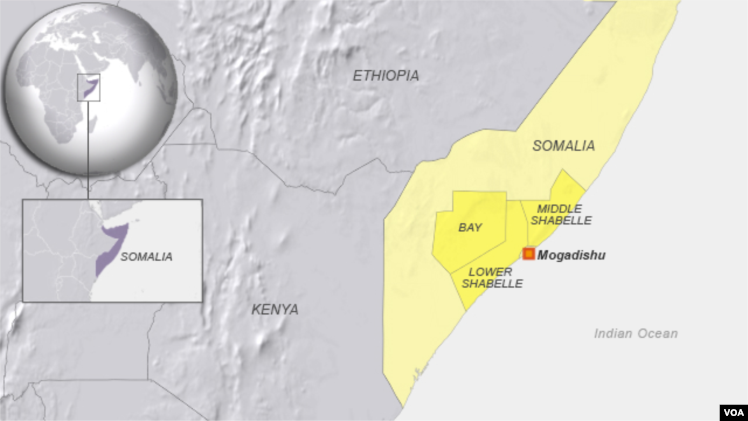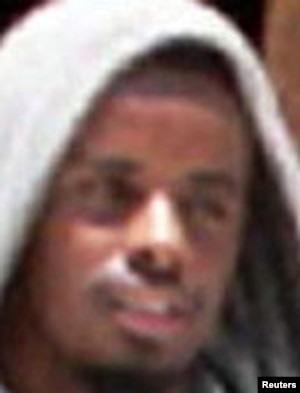Sources Describe Final Days of Al-Shabab's Godane

Lower Shabelle, Shabelle and Bay regions of Somalia
Sources disagree on why. Some say the al-Shabab militant leader and his comrades heard the sound of drones overhead. Some say they had stopped earlier, and were sitting near the car enjoying a snack of watermelon.
There is no disagreement on what happened next.
After they heard the drones, the men spread out and ran into the nearby jungle. Missiles started raining down immediately. Aerial bombardment of the area continued for about 20 minutes.

FILE - Ahmed Abdi aw-Mohamed, alias Ahmed Godane, is
pictured in an undated handout photo courtesy of the U.S. Department of
State.
Al-Shabab rescuers from two nearby towns moved toward the area cautiously, fearing further attacks.
They were also unsure who had been targeted; Godane traveled secretly for security reasons. But when they finally arrived, they found the body of Godane and two comrades about 250 meters from the wreckage of the car.
The man who had led al-Shabab for nearly seven years -- who brought the Islamist group to the brink of power in Somalia and forged its alliance with al-Qaida -- was dead, at the hands of what would soon be revealed as a U.S. missile strike.
This account of Godane’s last hours is based on interviews with Somali officials, regional security officials and sources close to al-Shabab, by VOA’s Somali Service.
Most declined to speak on the record for fear of retaliation by the militant group, which remains a dangerous force in Somalia.
The lone exception is the governor of the Lower Shabelle region, Abdulkadir Mohamed Nur.
Nur told VOA that Godane often came to Lower Shabelle, where al-Shabab still controls some territory.
“He was not the only one; al-Shabab foreigners loved the region, too,” he says. “The reasons are simple: People in the region are peaceful people, from a variety of backgrounds. This is a rich region with a river and lots of big farms and a jungle. It’s easy to hide.”
Nur declined to specify what role, if any, Somali government officials had in locating Godane ahead of the missile strike.
"A midwife doesn’t tell everything she knows,” he said. “We (the Somali government) were on his trail; international intelligences were on his trail. The combination of things helped.”
Cautious and unpredictable
Those who knew Godane’s habits said, for safety reasons, he was both cautious and unpredictable in his movements.
They said he often changed cars, rotated his group of 12 bodyguards -- drawn from three different clans -- and rarely drove with all of them so as to avoid drawing attention.
Sources said that in public Godane often covered his face, especially when traveling through towns. Sometimes he would pop up on front lines or make surprise appearances at meetings and mosques, then disappear quickly, they added.
Godane regularly changed his position, moving between spots in the Bay, Bakool, Middle Juba and Lower Shabelle regions.
However, his field of movement had shrunk in recent months, as al-Shabab lost significant areas in both Lower Shabelle and Bakool to African Union-led forces that are backed by the Somali government.
Limited contact
When it came to electronic communication, sources said Godane was aware of foreign intelligence voice-tracking.
He had avoided talking on telephones since September 2009, when U.S. Navy SEALs killed Saleh Ali Nabhan, an al-Qaida figure who allegedly played a role in the 1998 U.S. Embassy bombings in East Africa.
Godane was said to have communicated with his senior leadership team only by text messages.
Even with those precautions, multiple sources said that Godane feared for his safety.
One al-Shabab defector told VOA that the al-Shabab leader was afraid of drones, which the U.S. has used to kill other al-Shabab figures in Somalia.
Godane reportedly had barely escaped a U.S. drone strike in January.
The United States also had a $7 million price on his head, and he feared someone within his inner circle would betray him for the reward.
One security analyst who spoke to VOA believes that is what happened. The analyst thought Godane’s location was pinpointed through a cellphone in the car or a chip implanted in someone’s clothing.
Another theory: a Somali intelligence officer thinks Godane gave away his position through an ill-advised text message.
Final days in Lower Shabelle
Godane spent his final days traveling in Lower Shabelle.
Residents confirmed that Godane had met with local elders and farmers on August 30. He told them about jihad and said they should stand shoulder to shoulder with the mujahedeen.
Godane told them this, even though he knew that just 70 kilometers to the east, African Union troops and Somali government soldiers were pushing forward on two fronts -- one offensive targeting Sablale, the other toward Barawe, both towns controlled by al-Shabab.
One Somali official suggested Godane may have been thinking of going to a new area, deeper inside al-Shabab territory. Once the offensives drew closer, sources said Godane started moving to the northwest.
Godane was intercepted on one of the few major roads in southwest Somalia that al-Shabab still controls.
U.S. officials have not revealed what or who enabled them to locate and kill Godane.
Godane's name no longer appears on the State Department’s Rewards for Justice website -- although the names of several other identified al-Shabab leaders are listed, suggesting there may be additional U.S. drone strikes in Somalia.
No comments:
Post a Comment